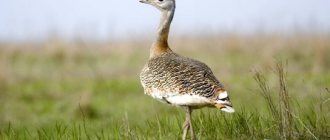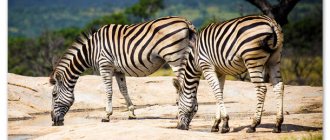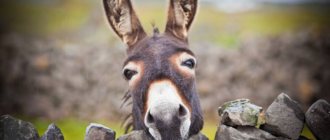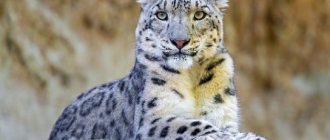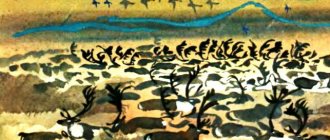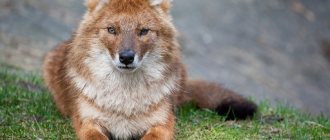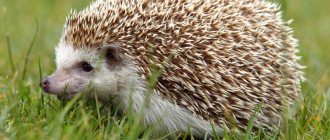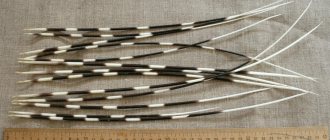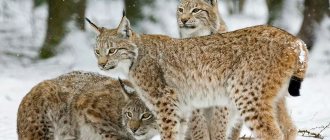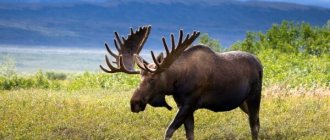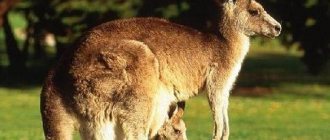- Reports and messages
- Animals
- Giraffe
Giraffe is a mammal, a genus of artiodactyls.
The giraffe is believed to be the tallest mammal on earth. The animal's height is six meters. Like everyone else, the giraffe has seven cervical vertebrae. Giraffes have an extremely strong heart because it has to circulate blood throughout the body, including pumping blood through the long neck all the way to the brain. In order for the vessels and veins to withstand the load when raising and lowering the head, evolution took care of this and made their blood thicker. They can clean their ears with their long tongue. The skin is mottled with black spots. Giraffes are very good runners, despite their thin legs. The speed exceeds sixty kilometers per hour. They can only walk on hard surfaces.
Giraffes fall asleep by curling up and bending their legs. Giraffes are also able to sleep standing up. A giraffe sleeps from ten minutes to two hours a day, as it has to get up and drink water. There are six species of giraffe, but five of them are extinct. The giraffe lives in Africa.
They feed on juicy acacia, mimosa, and delicious juicy fruits. Every day they take up to thirty kilograms of food. They can live without water for quite a long time. Can drink thirty-eight liters of water at a time.
Some giraffes live in packs, some alone. Reproduction occurs during the rainy season. Pregnancy lasts fourteen or fifteen months. A giraffe that was just born weighs one hundred kilograms. They live with their mother until they are 1.5 years old and then leave her. If a giraffe lives in the wild, its life expectancy is twenty-five years. Baby giraffes are hunted by leopards and lions.
Giraffes are exclusively herbivores. The giraffe's tongue is not damaged. Males, unlike females, eat more grass. Big and strong heart. The heart weighs ten kilograms. This is exactly the size that an animal needs for normal life.
Short description
The height of male giraffes reaches 5.6 m, females are a meter lower, and the neck of this giant stretches more than 2 meters. Weight of adults: up to 1900 kg (males) and up to 1200 kg (females). The weight of a newborn baby is 50 kg, height is about 2 meters.
The color is also interesting: the animal’s skin is covered with spots of various shapes and sizes; the specific pattern may vary depending on the habitat. The characteristics of these mammals are:
- Strong, long limbs, the hind limbs being shorter than the front ones.
- The neck includes 7 elongated vertebrae. Very strong and flexible.
- The back is sloping.
- The tail is long (up to 100 cm), thin, decorated with a tassel at the end, with the help of which the herbivore drives away flies and other flying insects.
- The head is crowned with horns - small bony protrusions covered with hair. In females they are thinner and end with tassels. A giraffe's horns are called ossicones.
- There is a bone growth on the forehead, which, unknowingly, can be mistaken for the third horn.
- The eyes are big.
- The tongue is black, up to 45 cm long.
- The color of the spots can vary depending on the species, from yellow to black.
This is what a giraffe looks like, it is truly an amazingly beautiful creature of nature that pleases the eye with its proud gait.
Even the heart of this giant is impressive in size and weighs more than 12 kg. It is capable of passing through itself up to 60 liters of blood per minute, this figure is 3 times higher than in humans. This feature of the body structure is inherent in all large animals.
Nutrition
Animals prefer only plant foods; he especially loves to eat acacia leaves. The giraffe is the tallest animal and thanks to its height, it deftly releases its long tongue, covers the branch and throws its head back, thereby emptying the branch of leaves. He can eat up to 30 kilograms of vegetation per day.
It receives water from plants and can go without water for several weeks. If he still wants to drink enough, he is forced to spread his legs wide so that his head can touch the base of the reservoir. In one sitting he is able to drink up to 40 liters of water. But the animal is very vulnerable at this time and he engages in this procedure when he is convinced that he is not in danger.
Habitats
Not everyone knows where the giraffe lives. The homeland of this beautiful animal is hot Africa, especially the latitudes located south of the Sahara Desert and in the north of Botswana. Due to human economic activity and especially hunting, artiodactyls gradually disappeared from West Africa, but they were preserved in the reserve of the Republic of Niger.
Habitat: arid regions of the continent; they prefer to settle in places where acacia grows; they are also found in savannas, meadows, and woodlands. Due to the specifics of the digestive system, giraffes eat very rarely, so the dry climate and small amount of vegetation do not frighten them.
In search of food, they are able to cover impressive distances, so one male, as a rule, accounts for from 5 to 650 square meters. km. Now many representatives of the species can be seen in various countries of the world, in nature reserves, which helps make it easier for children and adults to get to know them. However, in natural conditions it lives only in Africa.
Popular message topics
- Heroes of Space
We need to start the story about heroes of space with the people who made the flights themselves possible. The central figure on this list is rocket scientist K.E. Tsiolkovsky, - The works of Vladimir Korolenko
Vladimir Galaktionovich Korolenko is a Russian writer and a true master of words. The work of this writer is an integral part of fiction. - Rubber
Rubber is a substance of synthetic or natural origin. He became a real discovery for a person. For the first time, rubber in its natural form became known among the South American Incas, who used it for their own needs.
Lifestyle
Giraffes prefer to live socially, gathering in herds of 10 to 20 individuals. However, scientists were able to identify larger “families”, including more than 70 animals. The herd includes males, females and cubs of different ages. Moreover, each animal can leave the “family” or join it at will. Nobody will call him.
They lead a diurnal lifestyle, sleep at night, standing, with their head resting on their hind leg. Researchers have found out what the giraffe eats; the basis of its diet is the foliage of trees growing in its habitat. Are eating:
- acacia;
- apricot tree leaves;
- African mimosa;
- foliage of other trees and shrubs.
They are ruminant herbivores, so in hot weather they usually chew gum. They make practically no sounds, but males give a signal with a special “cough”, and females call their cubs by mooing, snorting and bleating. If necessary, they can “communicate” over long distances using ultrasound .
The giraffe has few natural enemies, which is due to its impressive height and strong, developed limbs. These include hyenas, wild dogs, and large representatives of the cat orders. The smallest cub of artiodactyls is the most vulnerable, but an adult animal is quite capable of standing up for itself.
Moreover, being herd animals, they always come to the aid of a member of the herd in trouble.
Capable of reaching speeds of up to 60 km/h.
Leave your comment
Sergei Kravtsov reported to Vladimir Putin on the progress of implementing key tasks in the education system
Reading time: 3 minutes
More than 347 thousand people take part in the Unified State Examination in social studies
Reading time: 1 minute
The government has allocated additional funds for cashback for children's holidays
Reading time: 1 minute
An Italian teacher gave children a summer assignment and became famous
Reading time: 4 minutes
Rosobrnadzor spoke about the preliminary results of the Unified State Exam 2021
Reading time: 3 minutes
MSUPE specialists have launched a project to modernize the methodological training of teachers
Reading time: 3 minutes
Gift certificates
Responsibility for resolving any controversial issues regarding the materials themselves and their contents is taken by the users who posted the material on the site. However, the site administration is ready to provide all possible support in resolving any issues related to the work and content of the site. If you notice that materials are being used illegally on this site, please notify the site administration using the feedback form.
All materials posted on the site were created by the authors of the site or posted by users of the site and are presented on the site for informational purposes only. Copyrights for materials belong to their legal authors. Partial or complete copying of site materials without written permission from the site administration is prohibited! The opinion of the administration may not coincide with the point of view of the authors.
Source
Specifics of reproduction
They are polygamous, so they do not form strong couples. The male determines the female’s readiness for mating by a specific smell and prepares to immediately begin the process. However, he often has to defend his superiority by entering into a fierce battle with an opponent. Giraffes carry out bloody massacres using their own head as the main “weapon”. The blows are quite powerful, but the fight rarely ends in the death of one of the fighters. Giraffes do not use their hooves to fight representatives of their genus.
The winner proceeds to mate, while the loser is forced to give up breeding or try his luck elsewhere. The winner does not pursue him.
The duration of pregnancy is 400-460 days, most often one baby is born, twins are rarely born. The height of the calf is up to 2 meters, it develops very quickly: in just a few hours it can already run, becoming a full-fledged member of its community.
The animal's lifespan is 10−12 years in the wild, 20−27 years in captivity, under good conditions.
How do they reproduce?
Giraffes reach sexual maturity at the age of 4-5 years. Their reproductive capacity remains until they are 18-20 years old. During this time, the female manages to bring 5-7 cubs.
The mating season usually begins in March-April, although some females become ready to mate out of season. The habits of giraffes during the breeding season are similar to the behavior of other animals: males enter into fights for the right to cover females, but do not cause serious injuries to each other, and the losing opponent continues to remain in the herd.
The female carries the cub for 15 months. Giraffes give birth standing up, so the newborn baby falls to the ground from a height of almost 2 m. He immediately gets to his feet and can follow his mother.
During the first days, the baby feeds only on mother’s milk, the fat content of which reaches 12-13%. From the age of two weeks he begins to try solid food. The female continues to feed the cub with milk until 8-10 months.
Variety of subspecies
Currently, the giraffe family includes only 1 species, although initially there were 5. The remaining 4 are considered extinct. The classification is based on habitat and the nature of the patterns on the body.
It is customary to distinguish 9 subspecies:
- Nubian. The main area of residence is Ethiopia and Sudan, it has chestnut spots with a white “rim”; males are distinguished by a characteristic growth on the forehead.
- Mesh (Somali). Spots with sharp edges, edged with white, color red-brown.
- Ugandan. The brown spot is decorated with a wide white stripe.
- Kordofan. A feature of the subspecies is the presence of medium-sized spots, unevenly distributed over the surface of the body. Most of them are concentrated on the limbs, at the bottom of the hock joints.
- South African. Characterized by a golden hue of the skin and round dark spots. Body length can reach up to 6 meters, weight - over a ton.
- Angolan. Lives in Namibia and Botswana, has large brown spots with elongated corners.
- Thornycroft. Found in Zambia, its skin is decorated with a fine jagged pattern.
- West African. It is an endangered species; small populations now inhabit Chad.
- Massai. Its spots are shaped like a five-pointed star.
These are the main types of giraffes that inhabit the planet.
Interesting facts about giraffes
There are many interesting facts about giraffes that allow you to look at these animals from an unexpected perspective. For example, members of the family sleep no more than a couple of hours a day, the average duration of an individual sleep is 10 minutes. Here is some more educational information about animals:
- My favorite “delicacy” is raw onions!
- The nature of the spots on the body is unique, in this feature it is similar to a human fingerprint.
- The neck consists of elongated vertebrae, however, despite this, it does not reach the ground. Therefore, to get drunk, the animal kneels down. At this moment it is most vulnerable to predators. The animal's skeleton is quite common for mammals, but it is the neck that makes it unique.
- They are able to avoid visiting a watering hole for several weeks, going without liquid. But once they get to the river, they replenish their reserves, drinking more than 30 liters at a time!
- They can only walk on solid ground due to their thin, long legs. Swampy soil is an insurmountable obstacle for them.
- They jump well, being able to overcome obstacles up to 1.5 meters high.
Pictures and photographs will help you see how graceful this animal is, despite its tall stature, thin limbs and long neck. A child in a zoology class will, of course, get to know where these beauties live and how the word “giraffe” should be spelled correctly, but parents can also tell him about what makes the animals remarkable.
Appearance
This species of mammal is the tallest living on the globe. Like many other representatives of artiodactyls, the male is larger than the female.
Its height ranges from 5-5 to 6-2 meters, and females from 4-6 to 5-8, respectively. You also need to pay attention to the fact that his height is greatly increased by his neck, which is 1.3 times the length of the giraffe’s entire body. Its weight ranges from 925-1250 kg.
A few more words about the neck of our giant; in practice, we have always observed seven cervical vertebrae in most individuals of this species. It would seem like nothing special, if not for one thing, but! The giraffe also has seven of them, but given the length of its neck, it makes you wonder how this is possible.
We have one explanation; nature foresaw everything in advance. Plus, the giraffe's body at one time suffered strong genetic changes. There is an opinion among scientists that it stretched out due to the fact that the animals fought with their necks against each other.
